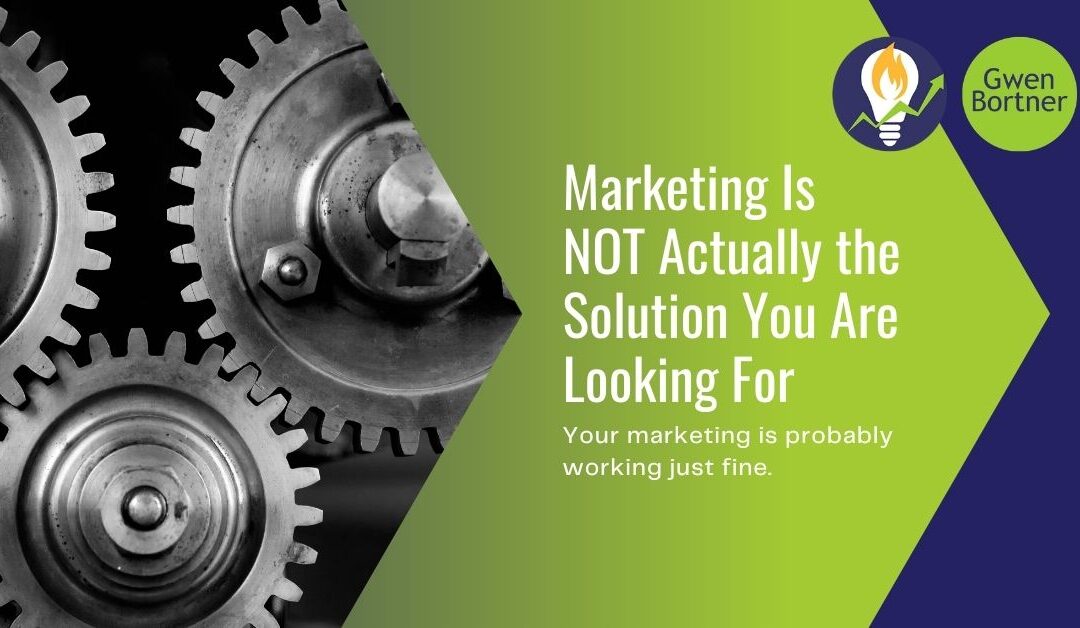
by Gwen Bortner | Marketing, Operations
As a successful entrepreneur and small business owner/CEO I know a few things about you:
- You are passionate about your business idea and the products and/or services you offer.
- You are most likely a visionary — with lots of ideas and the ability to see the amazing possibilities.
- Marketing and/or sales either comes naturally and has been your primary focus as you have created, developed, and grown your business.
All of these are excellent traits for an entrepreneur to possess and fundamentally are a key component to your success thus far. But in almost every small business there is an inflection point.
This point of inflection is fairly easy to identify for the owner as they start feeling stuck.
Stuck at a particular income level instead of consistently growing.
Stuck doing the same “boring” tasks instead of working in their zone of genius.
Stuck carrying all the burden of the business instead of enjoying the elusive entrepreneurial freedom so often touted.
Feeling stuck is your business trying to tell you that something is wrong (or maybe several somethings).
When most entrepreneurs feel stuck, their go-to solution is marketing. More ads, more posts, more offers. New tactics, new products, new programs. But, it is rare that the business’ marketing is actually the problem. So marketing will rarely help and in some cases will actually make things worse.
Instead it is time to look at the business’ operations.
I use the acronym GEARS for the parts of your business’ operations:
- Goods – Products and services you sell
- Effectiveness – Personal and team productivity, business leadership
- Accountability – Prioritizing what is important and taking consistent action to reach goals
- Resources – People, money, equipment, technology, and similar
- Systems – Processes, routines, and reporting
Most entrepreneurs are not operationally inclined; it is counter to their visionary gifts. So operations get overlooked or put on the back burner until an issue becomes critical. And then it gets addressed quickly, in a “make do” manner without lots of consideration for longer term effectiveness.
At the point of “stuck”, all of the patches, quick-fixes, and band-aids are no longer serving the business and the internal gears of your business are about to break. Your business has hit its operational capacity limit.
Unfortunately, what got you here (stuck), will rarely get you there (unstuck).
If you are feeling stuck and not sure where to start, sign up below to download your GEARS self-assessment, or click here to learn more. In just a few minutes you will identify which GEARS need to be addressed and how to prioritize your efforts for maximum benefit. Optimize your GEARS and you will be unstuck and moving forward before you know it!
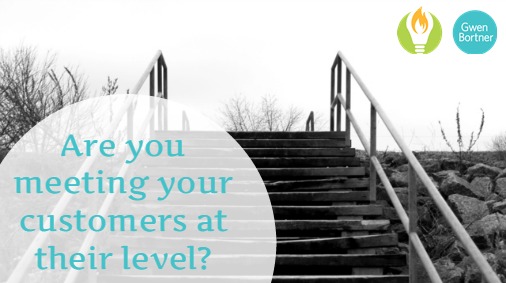
by Gwen Bortner | Marketing
A lot of entrepreneurs are in the problem-solving business: we help people do the things that will make life better. We solve the problems they know they have and sometimes, the problems they don’t. Are you helping your customers solve the problems they know about, or are you trying too soon to fix a problem they don’t know they have?
You understand that your product or service can solve someone’s problem. The question is: does your customer understand that, too? You can’t fix someone’s problem for them if they don’t know they have it. (A quick and easy example: I’m not currently in the market for termite services, but if you came to my house and showed me proof of termite damage, I’d suddenly BE in the market for those services. You’ve got to help me see the problem before I’m willing to pay for the solution.)
There are five basic levels of awareness that your customers have when it comes to their problems. Your job is to meet them at their current level and help them move toward the higher ones. I’ll use the example of a brick and mortar shop owner without a website as our sample customer.
Level 1: Ignorance isn’t Bliss
At this stage, your customer doesn’t know there’s a problem, at all. He’s a local toy store owner who is making occasional sales from customers who walk in off the street, and he thinks that’s pretty good! What more does he need? Nothing, as far as he’s concerned.
Level 2: Tip of the Iceberg
At this stage, your customer knows he has a problem, but has NO idea how to fix it. He probably thinks something like, “I’m not making enough sales to keep paying my rent on this shop.” So he realizes that he should be making more sales, but he isn’t sure how to go about doing that.
Level 3: Basic Awareness
At this stage, your customer knows that there might be options out there to solve his problem. He has seen other business owners employ sign wavers outside their shops, and he thinks maybe he should do that. He has also considered that maybe he needs a website like the store owner next door. He knows he has options, but he can’t connect those options to specific goals or results.
Level 4: Moving toward Choice
At this stage, your customer knows that if he had a website he could probably make more sales, but he isn’t sure the best way to do that. Should he hire someone to build it for him, or attempt a DIY solution? The choices are overwhelming, even though he already has an idea of a path to pursue.
Level 5: Solution-Ready
At this stage, your customer knows that he needs a website, and that you’re the best person to build it for him. He has already done research and has followed you on social media or visited your website so that he understands the credibility you bring to the table. At this stage he is ready to buy, and all you have to do is offer him something to purchase.
When you create a piece of content, like a blog post or email newsletter, you need to first think about the level of awareness your prospective customer has when he’s reading that content. Write the content to move him from one level up to the next, so that you can guide him on the path that will eventually lead to buying from you.
When you’re building your website or other platform, you should have content that appeals to your audience at the first four levels, because you never know someone’s level of awareness when they first come into contact with your work. As you grow your business, you can build sales funnels that start at each level (1-4), and move the customer up to level 5 with carefully crafted content.
Need a reminder? Download this free graphic to help you remember to move your audience through the levels! Just click on the image to save it to your computer:
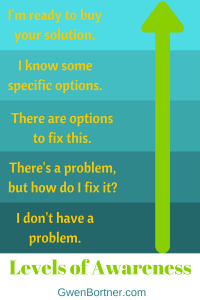
Are most of your customers coming to you at one specific level? How can you create content that will help them advance to the next one?
If you’d like to improve YOUR content marketing and speak to people at all levels of awareness, join us in June as we read Epic Content Marketing in the Small Biz Book Club! Throughout the month you’ll learn how to create content that meets your customers where they are and moves them through your sales cycle. Sign up below to join us in the club!
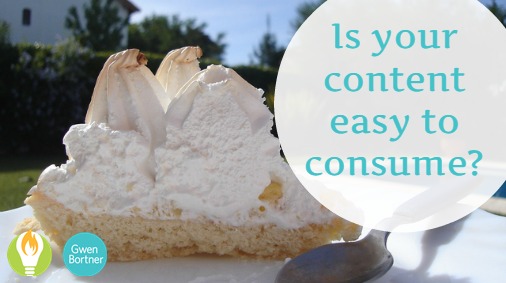
by Gwen Bortner | Tips & Tricks
Creating content is a valuable way to forge a connection with your customers and prospective customers. Having quality content on your website brings your customers back to your “home base” on a regular schedule, and communicates the idea that you are a trusted authority in your niche.
Have I convinced you yet that content is the key to building your business? Last week we talked about how to get the most out of one piece of content, and so this week I want to talk about streamlining that content for two reasons:
- Your customers will connect with your content more easily if it’s easy to consume and has a clear purpose.
- You will have an easier time writing the content if you have a clear plan before you begin.
What’s your purpose?
Before you begin to write any piece of content, you should think about your purpose in doing so. Is it…
- to entertain?
- to inform or educate?
- to sell something?
There’s a place for all of these purposes in the content plan for almost every business. Sometimes, it’s even good to combine them – after all, a dry piece of educational content isn’t nearly as fun to read as a witty, entertaining piece of content that also helps you learn something along the way, right? As another example, some of the best sales emails are written with educational content up front and a sales pitch at the end. Where you get into “content trouble” is not knowing what you’re trying to do with your content, or how you will use these three types of content individually or in pairs.
Before you create any piece of content, think first what you most want the customer to do when she finishes with the content, and use that as your overall purpose.
Dividing up the Content Pie
If you think of the content you put out into the world as a pie, how many slices are you devoting to sales content, vs. educational or entertaining content? The answer should be: “not many!” The purpose of a sales pitch is to offer a customer something right in the moment that he’s ready to buy it; but that customer has to have at least a few interactions with you before he’s ready to buy anything. Most people don’t just show up on your website and immediately purchase the first thing they see.
The amount of interaction required will vary with several factors, including:
- the cost of the item you’re selling
- the relationship you’ve built up in your industry
- the customer’s frustration level with his current situation
- your product’s likely ability to remove his frustration
Think of every piece of content you create as a way to build a relationship with someone who will eventually buy your products or services. How will you introduce that customer to you, your business, and your ability to solve his problems? Use your content to explain that!
Making a Call to Action
When you create content, you should have not only one purpose in mind, but also one action you want the customer to take. If you’re asking someone to click a link here to read a blog post, and then sign up over there for another list, and then find a download in this other place – that’s too many choices. Give your customer ONE thing to do, and it’s more likely that she’s actually going to do it.
Here are some sample calls to action you can make with a single piece of content:
- sign up for an email list
- download something (a free PDF or ebook or resource guide)
- click “like” or “share” or “retweet”
- forward the email to a friend
- hit reply and answer a question
- purchase something
So, to sum up: pick one focus, create plenty of opportunities for your customers to connect with you via content without selling them anything, and pick ONE call to action to bring your reader closer to being a buyer and lifelong fan. Not only will this process make it easier for you to create content, but it makes the content more likely to connect with your audience. It’s a win-win for everyone!
Did you find THIS content interesting or helpful? Share it with your friends & followers! Click the link to tweet this:
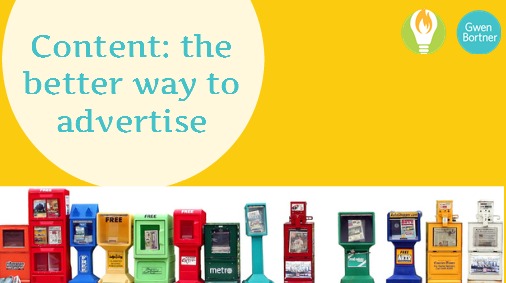
by Gwen Bortner | Abundance, Marketing
One of the things I love most about reading business books is that I don’t always have to invent brand-new ideas for my business; instead, I can find great ideas in the pages of these books. Starting in April, I’ll be leading a book study of Brandscaping by Andrew M. Davis for the Small Biz Book Club, so today I wanted to share an example of how this book gave me a great idea.
Of course, you already know that I got the idea for the entire book club from Brandscaping, but that wasn’t the only gem I found when I read it. I was actually able to get an idea to help one of my consulting clients, too! Here’s how:
Advertising: Worth it or not?
My client and I were discussing an opportunity she had to advertise in a local community magazine (this client runs a brick and mortar craft supply shop). The advertising cost was somewhat steep, but she felt it might help her generate some local business for her shop. After all, that is often our go-to place to drum up business, right? Advertising. However, that doesn’t mean it’s always the best option.
Since I had read Brandscaping, I knew that advertising only gets you so far: a little bit of exposure in a single publication. Let’s be honest – how often do you actually read the ads in a magazine, instead of just skimming over them to get to the content?
Don’t advertise – Brandscape
With that in mind, I suggested to my client that instead of paying for an ad, she pitch herself to the magazine editor as a prospective contributor.
I told my client that she could write regular articles for this publication, centered around a topic that would be of interest to the local readers and help to promote her shop. (In this case, the topic was home decor tips using handmade projects, for which the readers could come to her shop to purchase supplies.) This is a win-win scenario, because the magazine editor gets regular, fresh content for her publication and the shop owner gets free advertising (heck, the magazine might even pay her to write the pieces!).
Share the Love
I told my client that if she was worried about generating enough content for regular publication, she could extend the “brandscape” even further by inviting a few other shop owners to contribute to the column as well. They could team up and divide the work so no one would have to find the time and inspiration to write one article every time the magazine was published. As long as she chose shop owners who could also write about the general topic without directly competing with her for business, this would be a great way to take some of the pressure off of her and add a few more networking relationships with other small business owners.
If I hadn’t read Brandscaping, I never would have had this idea. What will be the next great idea YOU have for your business? Will you find it in a book?
If you’d like to read Brandscaping and get a FREE weekly study guide to help you stay on track and apply the material to your small business, sign up below to be notified when the study guide goes live. It’s entirely free, and I hope to see you in the club!

by Gwen Bortner | Show Your Work
If you are anywhere near my age, you remember the old Wendy’s commercials with the little old lady asking, “Where’s the beef?” It is an iconic commercial of the 1980’s.
For the last few weeks, the question I have been asking as I work through starting a new business is, “Where’s the market?” I know they exist. I see glimpses of them all around the Internet. I read snippets of their stories on Facebook, Twitter or various blogs. But interacting with them in a meaningful way just isn’t as easy as the various marketing gurus make it sound.
(more…)








